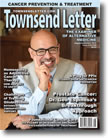|
As an integrative family physician, providing help for my patients with cancer had been a practice-long emotional drain for my staff and me. For the first 20 some years, I diagnosed cancer and referred my patients to oncology. Then we watched as they struggled to tolerate treatments while trying to continue a viable life. Later in their courses of treatment, they were struggling to stay alive, and then more often than not, they conceded to hospice. A few would return to us in dire conditions having been told there was nothing more that medicine could do for them. Some survived for a time, only to face a recurrence 5 to 15 years later. We supported them with whatever was available to us at the time.
The transformation of my education to integrative medicine gave my practice a breath of fresh air. The patients with difficult health conditions that no one could solve and caused my staff to groan as they walked through the door became (well, for the most part) our best patients. I found I could do so much more for my patients; transforming helplessness into hopefulness. So too, was the change in my ability to help my cancer patients.
Following a fellowship in integrative cancer therapies, I began IV nutritional therapies for our cancer patients being treated by oncology. We also offered IV nutritional therapies to those who had been treated by oncology and were in "remission" but who were left with generally weakened health. In 2012, I added IV Salicinium as a primary adjunctive and supportive intervention with impressive results. My best successes by far have been with Salicinium.
I was privileged to meet once again with Ioannis Papasotiriou, MD, PhD, at the Best Answer for Cancer conference in San Diego this spring. Papasotiriou is the head of molecular biology and founder of Research Genetics Cancer Centre (RGCC) in Greece. We discussed the results of his continued sensitivity testing of Salicinium over the past year. After 9000 tests, Salicinium has maintained its status of efficacy, which is an incredible achievement. Compared with chemosensitivity testing of the various chemotherapeutic agents, none have attained numbers even close! Additionally, Salicinium is compatible with most chemotherapy. Initial RGCC chemosensitivity and natural substances testing helps our patients make viable choices for their treatments.
IV Salicinium is as easy to use as IV vitamin C, ozone, and so on, and the actual infusion portion of the program (3 weeks) is much shorter. I am using IV vitamin C and ozone as a comparison but should note that they are both contraindicated with Salicinium. Patients typically begin to feel better by the second week of infusions, and many are able to continue working as the daily infusions require less than 2 hours of the patient's time. Orasal (oral Salicinium) is continued afterward until testing indicates adequate improvement. We follow progress with monthly nagalase testing, and periodic routine lab tests, including testing for any positive CA markers and for immune status. RGCC testing is performed every 3 to 6 months and imaging as necessary.
All imaging must be interpreted with an understanding of the process. Because of Salicinium's rapid rate of efficacy, tumor edema and swelling may occur in areas of tumor death as the immune response (clean-up crew) creates inflammation. Previously undetectable tumors and metastases may become evident on imaging due to the increase in size. For example, a lesion may increase in size from 3 mm to 4 mm, which can then be detected with current imaging techniques. Careful interpretation of the images must also be done, as soft tissue lesions respond much more quickly than bony lesions, which may take months to disappear. During the intervention, PET and CT scanning will reveal a "moth-eaten" look or weakly reactive soft tissue lesions such as lymph nodes that are responding while the skeletal lesions remain "bright" much longer. It is imperative to ask questions of the radiologist if the description of the lesions is not clear. Blood testing must accompany any attempt to determine progress by imaging to avoid confusion.
This is now my 4th year using IV Salicinium for my patients. We have a 67% survival rate (alive and active). Less than 10% of my patients had not chosen routine care (chemo/radiation/surgery) prior to coming to us. In other words, for 90% of our patients, cancer itself and the treatment "side effects" have already physically and emotionally disadvantaged their recovery.
I would like to share a few new patient experiences with you.
Jane: 57-Year-Old Female
Oct. 2, 2015 Diagnosis: grade IV glioblastoma. Jane had begun to lose sight and had a seizure and fell. Brain MRI revealed a lesion involving the left temporal lobe, basal ganglia, and invasion of the hypothalamus, optic chiasm, canalicular optic nerves, and sella. She and her family were told that her condition was fatal, and she was offered palliative care involving chemotherapy, as radiation could not be done without damage to vital structures. She and her family sought a less toxic quality of life in the light of the condition's fatality. She received the usual 3 week IV Salicinium regimen in December 2015 and transitioned to blood level maintenance with the Orasal protocol. Her most recent MRI demonstrates lessening of the basal ganglia and pituitary lesions. Her vision has not returned, but she has not had recurrent seizures. She is without pain and mobile with a wheelchair because of unsteadiness and blindness. She is alive and alert, eating, and conversing with her husband and daughters 6 months following treatment.
Collette: 72-Year-Old Female
2009 Diagnosis: Right Breast Cancer ER+, PR-, HER-2/NEU+, T1aNOMx. Prior treatment: lumpectomy. Collette declined adjuvant therapy following lumpectomy. However, she experienced a recurrence in October 2014. The palpable lesion was verified on thermogram but not seen on mammogram. She requested a biopsy from her breast cancer surgeon revealing tumor characteristics identical to the original cancer.
Throughout her life Collette always sought less toxic treatments and came to our practice for help. She received IV Salicinium beginning on November 28, 2014. She has chosen to continue the Orasal protocol to date, as the nagalase has very slowly but steadily declined. The RGCC circulating tumor cell count (CTC) is slightly below the reference range, and the nagalase has dropped from 2.04 to 1.02. She reports that she is "feeling better than she has in years!"
Carol: 70-Year-Old Female
1994 Diagnosis: Right breast cancer with chest wall dermal invasion, ER+, PR+, HER-2/NEU (C-ERBb-2). Treatment: mastectomy 1994, mastectomy scar recurrence 2005, 2011, 2014 with positive axillary node resection 2011. 2014 Diagnosis: Right renal cell carcinoma.
Carol is crippled from lifelong rheumatoid arthritis and has been through every immunosuppressant therapy available. She was unable to convince herself to undergo another potentially debilitating treatment and declined surgery. We discussed the potential for cure with nephrectomy but she felt too fragile for surgery (her husband agreed). She requested the same treatment that her sister (Collette, above) had and she began IV Salicinium 1 month later, on December 28, 2014. To date imaging has revealed decreasing tumor size and she is doing well. Venous access is difficult and she declines other imaging where such would be required.
She experienced a recurrence of the breast cancer with pulmonary metastasis; months after her nagalase had reduced to acceptable levels and she was off Orasal. (Nagalase measures active tumor burden. RGCC measures circulating tumor cells [CTCs].) An RGCC test August 25, 2015, indicated 10.4 cells/ml with aggressive breast cancer tumor genetics and multidrug resistance. The reference range is below 0.5. She declined further attempts for IV access and is doing very well with Orasal. Her chest X-ray indicates regression of the lesions and reduction of effusion. She reports feeling very well.
This brings me to a new application of Orasal. I have included photographs of two of our patients who have used only Orasal.
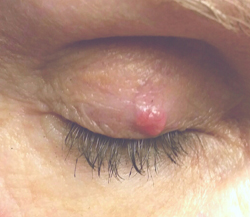 |
Nancy: 2016 Carcinoma Left Eyelid.
Prior Treatment: None |
| |
|
Nancy was prescribed Orasal and has used it as directed.
Nancy's lesion is appreciably less vascular and smaller over only 11 days' time, suggesting early resolution. |
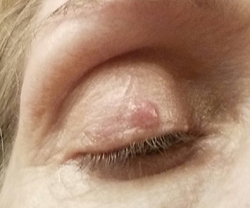 |
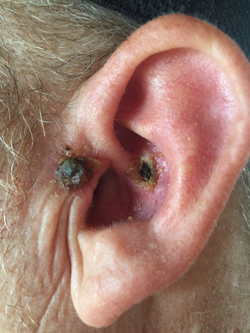 |
Mike: 2016 Basal cell carcinoma left ear.
Prior treatment: None
Before: May 8, 2016 |
| |
|
May 26, 2016: 18 days later
The larger lesion, located near the tragus, is much less vascular and appears to be healing. The smaller lesion on the inner pinna (less blood supply) is improving more slowly. |
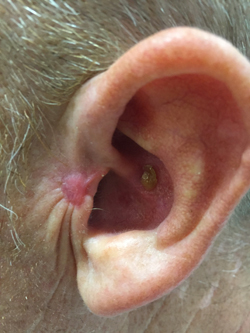 |
Mike also had 21 other lesions on his head, neck, and shoulders, and all but 2 of those have resolved as of this writing. Mike has had a long history of such lesions and many potions to remove them.
In conclusion, it's my practice to put all my cancer patients on IV Salicinium and Orasal or simply Orasal alone if they cannot undergo IV therapy. As mentioned at the outset, the mental groaning and difficulties involved with trying to help the untreatable have all but disappeared from my office. Seeing the burden slowly being lifted from the patients' facial expressions as they actually improve is indescribable.

Carol M. Brown, DO, PhD, FAARFM, is the founder and medical director of CMB Health Specialties. She began her career as a registered medical technologist in 1964 and received her bachelor of science degree in 1971, her doctorate in osteopathic medicine in 1976, and doctorate in Integrative medicine in 2005. Dr. Brown is board-certified in emergency medicine, occupational and environmental medicine, and functional anti-aging and regenerative medicine. She also completed a fellowship in integrative cancer therapies in 2011. She maintains clinical associate professorships at Marquette University, the University of Wisconsin-Milwaukee, Carroll University, and Midwestern University in Downers Grove, Illinois. Through her passion for learning, healing, and the skillful integration of conventional and alternative medicine, Dr. Brown's practice offers her patients renewed vitality.
|
![]()
![]()
![]()




